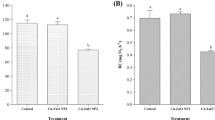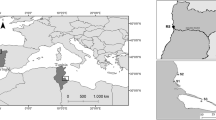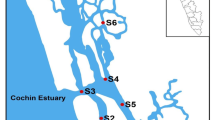Abstract
The release of acidic effluents, naturally enriched in metals and radionuclides, is the main legacy of uranium mines. Generally, metals dissolved by these acidic effluents can cause significant alterations in exposed organisms, with distinct toxicological outcomes. In this study, 72 individuals of the freshwater fish species Carassius auratus were exposed in situ for different periods (8, 16, 24, and 48 h) to water from a pond (treatment pond (TP)) with a chemically treated effluent and a reference pond (PRP), in the vicinity of the Cunha Baixa uranium mine (Portugal). Comparing the water of the two ponds, the PRP pond was characterized by higher pH and oxygen values and lower conductivity and hardness values. Regarding total metal concentrations, among others, magnesium (56,000 μg/L), sodium (17,400 μg/L), zinc (86 μg/L), manganese (6340 μg/L), and uranium (1380 μg/L) concentrations in the TP pond were above the values obtained for the PRP pond. The values of manganese and uranium exceeded the values of quality criteria established for surface waters for cyprinids and for irrigation purposes. After exposure to pond water, significant differences were recorded for several biomarkers: (i) between ponds for acetylcholinesterase (AChE) with higher activities for animals from the PRP and glutathione-S-transferase (GST) activities that were particularly enhanced in animals from the TP pond; (ii) between ponds and exposure periods for lactate dehydrogenase (LDH) activity, since organisms from PRP pond presented always higher values than those from the TP pond, and among these, organisms exposed for the longer period presented a further depression in LDH activity; and (iii) between exposure periods for erythrocyte micronucleus. GSTs and LDH were the most sensitive biomarkers within the timeframe of the in situ assay performed. Despite the alleged efficacy of the chemical treatment (evidenced by a significantly lower pH), some metals persisted in the treated effluent (TP pond), potentially contributing to the induction of oxidative stress or increased conjugation metabolic activity in fish.


Similar content being viewed by others
References
Aebi H (1984) Catalase in vitro. Method Enzymol 6:105–121
Ahmad I, Hamid T, Fatima M, Chand HS, Jain SK, Athar M, Raisuddin S (2000) Induction of hepatic antioxidants in freshwater catfish (Channa punctatus) is a biomarker of paper mill effluent exposure. Biochim Biophys Acta 1519:37–48
Antunes SC, Pereira R, Gonçalves F (2007) Acute and chronic toxicity of effluent water from an abandoned uranium mine. Arch Environ Contam Toxicol 53:207–213
Antunes SC, Castro BB, Pereira R, Gonçalves F (2008) Contribution for tier I of the ecological risk assessment of Cunha Baixa uranium mine (Central Portugal): II soil ecotoxicological screening. Sci Total Environ 390:387–395
APHA (1995) Standard methods for the examination of water and wastewater, 19th edn
ASTM (1980) Standard practice for conducting acute toxicity tests with fishes, macroinvertebrates and amphibians. Report E-790-80 Annual Book of ASTM Standards. American Society for Testing and Materials, Philadelphia
Barata C, Lekumberri I, Vila-Escalé M, Prat N, Porte C (2005) Trace metal concentration, antioxidant enzyme activities and susceptibility to oxidative stress in the tricoptera larvae Hydropsyche exocellata from the Llobregat river basin (NE Spain). Aquat Toxicol 74:3–19
Baršienè J, Dedonytė V, Rybakovas A, Andreikėnaitė L, Andersen OK (2006) Investigation of micronuclei and other nuclear abnormalities in peripheral blood and kidney of marine fish treated with crude oil. Aquat Toxicol 78S:99–104
Bolognesi C, Perrone E, Roggieri P, Pampanin D, Sciutto A (2006) Assessment of micronuclei induction in peripheral erythrocytes of fish exposed to xenobiotics under controlled conditions. Aquat Toxicol 78S:93–98
Brandão F, Correia AT, Gonçalves F, Nunes B (2013) Effects of anthropogenic metallic contamination on cholinesterases of Gambusia holbrooki. Mar Pollut Bull 76(1–2):72–76
Bradford M (1976) A rapid and sensitive method for quantification of microgram quantities of protein utilizing the principle of protein–dye binding. Anal Biochem 72:248–254
Bussy C, Lestaevel P, Dhieux B, Amourette C, Paquet F, Gourmelon P, Houpert P (2006) Chronic ingestion of uranyl nitrate perturbs acetylcholinesterase activity and monoamine metabolism in male rat brain. Neurotoxicology 27:245–252
Canli EG, Canli M (2015) Low water conductivity increases the effects of copper on the serum parameters in fish (Oreochromis niloticus). Envir Toxicol Pharmacol 39:606–613
Carrasco KR, Tilbury KL, Myers MS (1990) Assessment of the piscine micronuclei test as an in situ biological indicator of chemical contaminant effects. Can J Fish Aquat Sci 47:2123–2136
Carvalho FP, Madruga MJ, Reis MC, Alves JG, Oliveira JM, Gouveia J, Silva L (2007) Radioactivity in the environment around past radium and uranium mining sites of Portugal. J Environ Radioact 96:39–46
Carvalho CS, Bernusso VA, Fernandes MN (2015) Copper levels and changes in pH induce oxidative stress in the tissue of curimbata (Prochilodus lineatus). Aquat Toxicol 167:220–227
Castro BB, Sobral O, Guilhermino L, Ribeiro R (2004) An in situ bioassay integrating individual and biochemical responses using small fish species. Ecotoxicology 13:667–681
Çavaş T, Ergene-Gözükara S (2003) Micronuclei, nuclear lesions and interphase silver-stained nucleolar organizer regions (AgNORs) as cyto-genotoxicity indicators in Oreochromis niloticus exposed to textile mill effluent. Mutat Res 538:81–91
Çavaş T, Ergene-Gözükara S (2005) Induction of micronuclei and nuclear abnormalities in Oreochromis niloticus following exposure to petroleum refinery and chromium processing plant effluents. Aquat Toxicol 74:264–271
Charron L, Geffard O, Chaumot A, Coulaud R, Queau H, Geffard A, Dedourge-Geffard O (2013) Effect of water quality and confounding factors on digestive enzyme activities in Gammarus fossarum. Environ Sci Pollut Res Int 20(12):9044–56
Coulaud R, Geffard O, Xuereb B, Lacaze E, Quéau H, Garric J, Charles S, Chaumot A (2011) In situ feeding assay with Gammarus fossarum (Crustacea): modelling the influence of confounding factors to improve water quality biomonitoring. Water Res 45(19):6417–6429
de la Torre FR, Salibián A, Ferrari L (2007) Assessment of the pollution impact on biomarkers of effect of a freshwater fish. Chemosphere 68:582–1590
Dautremepuits C, Betoulle S, Vernet G (2002) Antioxidant response modulated by copper in healthy or parasitized carp (Cyprinus carpio L.) by Ptychobothrium sp. (Cestoda). Biochim Biophys Acta 1573:4–8
Dogan Z, Eroglu A, Kanak EG, Atli G, Canli M (2014) Response of antioxidant system of tilapia (Oreochromis niloticus) following exposure to chromium and copper in differing hardness. Bull Environ Contam Toxicol 92:680–686
Ellman GL, Courtney KD, Andres V, Featherstone RM (1961) A new and rapid colorimetric determination of acetylcholinesterase activity. Biochem Pharmacol 7:88–95
Elumalai M, Antunes C, Guilhermino L (2002) Effects of single metals and their mixtures on selected enzymes of Carcinus maenas. Water Air Soil Poll 141:273–280
Elumalai M, Antunes C, Guilhermino L (2007) Enzymatic biomarkers in the crab Carcinus maenas from the Minho River estuary (NW Portugal) exposed to zinc and mercury. Chemosphere 66:1249–1255
Frasco MF, Guilhermino L (2002) Effects of dimethoate and beta-naphthoflavone on selected biomarkers of Poecilia reticulata. Fish Physiol Biochem 26:149–156
Freitas DRJ, Rosa RM, Moraes J, Campos E, Logullo C, Da Silva Vaz Jr I, Masuda A (2007) Relationship between glutathione-S-transferase, catalase, oxygen, consumption, lipid peroxidation and oxidative stress in eggs and larvae of Boophilus microplus (Acarina: Ixodidae). Comp Biochem Physiol A 146:688–694
Fulton MH, Key PB (2001) Acetylcholinesterase inhibition in estuarine fish and invertebrates as an indicator of organophosphorus insecticide exposure and effects. Environ Toxicol Chem 20:37–45
Guilherme S, Válega M, Pereira ME, Santos MA, Pacheco M (2008) Erythrocytic nuclear abnormalities in wild and caged fish (Liza aurata) along an environmental mercury contamination gradient. Ecotoxicol Environ Saf 70:411–421
Gustavino B, Scornajenghi KA, Minissi S, Ciccotti E (2001) Micronuclei induced in erythrocytes of Cyprinus carpio (teleostei, pisces) by X-rays and colchicines. Mutat Res 494:151–159
Habig WH, Pabst MJ, Jakoby WB (1974) Glutathione-S-transferases—the first enzymatic step in mercapturic acid formation. J Biol Chem 249:7130–7139
Hodgson E, Levi P (2004) Hepatotoxicity. In: Hodgson E (ed) A textbook of modern toxicology. Wiley Interscience, New Jersey, pp 263–272
INAG (2009) Critérios para a Classificação do Estado de Massas de Água Superficiais – Rios e Albufeiras. Instituto da Água, IP. Ministério do Ambiente, do Ordenamento do Território e do Desenvolvimento Regional. Lisboa, Portugal
Lange B, Vejdelek ZJ (1980) Photometrische Analyse. Verlag Chemie, Weinheim
Leblanc GA (2004) Acute toxicity. In: Hodgson E (ed) A textbook of modern toxicology. Wiley Interscience, New Jersey, pp 215–224
Lemos CT, Rödel PM, Terra NR, Oliveira NCA, Erdtmann B (2007) River water genotoxicity evaluation using micronucleus assay in fish erythrocytes. Ecotoxicol Environ Saf 66:391–401
Liu H, Wang W, Zhang J, Wang X (2006) Effects of copper and its ethylenediaminetetraacetate complex on the antioxidant defenses of the goldfish, Carassius auratus. Ecotoxicol Environ Saf 65:350–354
Lourenço J, Pereira R, Silva A, Morgado J, Carvalho F, Oliveira J, Malta M, Paiva A, Mendo S, Gonçalves F (2011) Genotoxic endpoints in the earthworms sub-lethal assay to evaluate natural soils contaminated by metals and radionuclides. J Hazard Mater 186:788–795
Lourenço J, Pereira R, Silva A, Carvalho F, Oliveira J, Malta M, Paiva A, Gonçalves F, Mendo S (2012) Evaluation of the sensitivity of genotoxicity and cytotoxicity endpoints in earthworms exposed in situ to uranium mining wastes. Ecotoxicol Environ Saf 75:46–54
Lushchak OV, Kubrak OI, Lozinsky OV, Storey JM, Storey KB, Lushchak VI (2009) Chromium (III) induces oxidative stress in goldfish liver and kidney. Aquat Toxicol 93:45–52
MA (1998) Decreto lei n° 236/98 de 1 de Agosto. Ministério do Ambiente. Diário da República I série, A 176:3676-3722
MAOT (2010) Decreto-Lei n.º 103/2010 de 24 de Setembro. Ministério do Ambiente e do Ordenamento do Território. Diário da República I série 187:4289–4296. Lisboa, Portugal
Marques SM, Antunes SC, Pissarra H, Pereira ML, Gonçalves F, Pereira R (2009) Histopathological changes and erytrocytic nuclear abnormalities in Iberian green frogs (Rana perezi Seoane) from a uranium mine pond. Aquat Toxicol 91:187–195
Marques SM, Antunes SC, Nunes B, Gonçalves F, Pereira R (2011) Antioxidant response and metal accumulation in tissues of Iberian green frogs (Pelophylax perezi) inhabiting a deactivated uranium mine. Ecotoxicology 20:1315–1327
Michaelidis B, Spring A, Pörtner HO (2007) Effects of long-term acclimation to environmental hypercapnia on extracellular acid–base status and metabolic capacity in Mediterranean fish Sparus aurata. Mar Biol 150:1417–1429
Minissi S, Ciccotti E, Rizzoni M (1996) Micronucleus test in erythrocytes of Barbus plebejus (Teleostei, Pisces) from two natural environments: a bioassay for the in situ detection of mutagens in freshwater. Mutat Res 367:245–251
Nunes B, Caldeira C, Pereira J, Gonçalves F, Correia AT (2015a). Chronic effects of realistic concentrations of non-essential and essential metals (lead and zinc) on oxidative stress biomarkers of the mosquitofish, Gambusia holbrooki. Archives of Environmental Contamination and Toxicology 69(4):586-95. doi: 10.1007/s00244-015-0190-3.
Nunes B, Caldeira C, Pereira JL, Gonçalves F, Correia AT (2015b). Perturbations in ROS-related processes of the fish Gambusia holbrooki after acute and chronic exposures to the metals copper and cadmium. Environmental Science and Pollution Research 22(5):3756-65.
Nunes B, Capela RC, Rodrigues S, Caldeira C, Gonçalves F, Correia AT (2014a). Chronic effects of lead, copper, zinc, and cadmium on biomarkers of the European eel, Anguilla anguilla. Environmental Science and Pollution Research 21(8):5689-700.
Nunes B, Barbosa AR, Antunes SC, Gonçalves F (2014b) Combination effects of anticholinesterasics in acetylcholinesterase of a fish species: effects of a metallic compound, an organophosphate pesticide and a pharmaceutical drug. Environmental Science and Pollution Research 21(9):6258-62.
Nunes B (2011) The use of cholinesterases in ecotoxicology. Rev Environ Contam Toxicol 212:29–59
Nunes B, Carvalho F, Guilhermino L (2006) Effects of widely used pharmaceuticals and a detergent on a oxidative stress biomarkers of the crustacean Artemia parthenogenetica. Chemosphere 62:581–594
Oliva M, Perales JA, Gravato C, Guilhermino L, Galindo-Riaño MD (2012) Biomarkers responses in muscle of Senegal sole (Solea senegalensis) from a heavy metals and PAHs polluted estuary. Mar Pollut Bull 64(10):2097–2108
Oliveira JMS, Ávila PF (2001) Geochemistry of the surrounding area of Cunha Baixa uranium mine (Mangualde, Centre of Portugal). Estudos, Notas e Trabalhos, Tomo 43. Instituto Geológico e Mineiro. Lisboa, Portugal
Ozmen M, Güngördü A, Kucukbay Z, Güler RE (2006) Monitoring the effects of water pollution on Cyprinus carpio in Karakaya Dam Lake, Turkey. Ecotoxicology 15:157–169
Pereira AMM, Soares AMVM, Gonçalves F, Ribeiro R (2000) Water-column, sediment, and in situ chronic bioassays with cladocerans. Ecotoxicol Environ Saf 47:27–38
Pereira R, Antunes SC, Marques SM, Gonçalves F (2008) Contribution for tier I of the ecological risk assessment of Cunha Baixa uranium mine (Central Portugal): I soil chemical characterization. Sci Total Environ 390:377–386
Quinn GP, Keough MJ (2002) Experimental design and data analysis for biologists. Cambridge University Press, Cambridge, p 537
Rao JV (2006) Biochemical alterations in euryhaline fish, Oreochromis mossambicus exposed to sub-lethal concentrations of an organophosphorus insecticide, monocrotophos. Chemosphere 65:814–1820
Richetti SK, Rosemberg DB, Ventura-Lima J, Monserrat JM, Bogo MR, Bonan CD (2011) Acetylcholinesterase activity and antioxidant capacity of zebrafish brain is altered by heavy metal exposure. Neurotoxicology 32:116–122
Saglam D, Atli G, Canli M (2013) Investigations on the osmoregulation of freshwater fish (Oreochromis niloticus) following exposures to metals (Cd, Cu) in differing hardness. Ecotoxicol Environ Saf 92:79–86
Sanchez W, Palluel O, Meunier L, Coquery M, Porcher J, Aït-Aïssa S (2005) Copper-induced oxidative stress in three-spined stickleback: relationship with hepatic metal levels. Environ Toxicol Pharmacol 19:177–183
Santos D, Milatovic D, Andrade V, Batoreu MC, Aschner M, Marreilha dos Santos AP (2012) The inhibitory effect of manganese on acetylcholinesterase activity enhances oxidative stress and neuroinflammation in the rat brain. Toxicology 292:90–98
Santos Oliveira JM, Ávila PF (1998) Geochemistry study in the surrounding area of Cunha Baixa mine (Mangualde, Centre of Portugal). Relatório do Instituto Geológico e Mineiro. Lisboa, Portugal
Schrader M, Fahimi HD (2006) Peroxisomes and oxidative stress. Biochim Biophys Acta 1763:1755–1766
Sen A, Semiz A (2007) Effects of metals and detergents on biotransformation and detoxification enzymes of leaping mullet (Liza saliens). Ecotoxicol Environ Saf 68:405–411
Sheppard SC, Sheppard MI, Gallerand M-O, Sanipelli B (2005) Derivation of ecotoxicity thresholds for uranium. J Environ Radioact 79:55–83
Stegeman JJ, Brouwer M, Di Giulio RT, Förlin L, Fowler BA, Sanders BM, Van Veld PA (1992) Molecular responses to environmental contamination: enzyme and protein systems as indicators of chemical exposure and effect. In: Huggett RJ, Kimerle RA, Mehrle PM Jr, Bergman HL (eds) Biomarkers. Biochemical, physiological, and histological markers of anthropogenic stress. The SETAC Publication Series Lewis Publishers, Chelsea, pp 235–336
Stoiber T, Bonacker D, Böhm K, Bolt H, Thier R, Degen G, Unger E (2004) Disturbed microtubule function and induction of micronuclei by chelate complexes of mercury (II). Mutat Res 563:97–106
Sun Y, Yu H, Zhang J, Yin Y, Shen H, Lui H, Wang X (2006) Bioaccumulation and antioxidant responses in goldfish Carassius auratus under HC Orange No. 1 exposure. Ecotoxicol Environ Saf 63:430–437
Tilton FA, Bammler TK, Gallagher EP (2011) Swimming impairment and acetylcholinesterase inhibition in zebrafish exposed to copper or chlorpyrifos separately, or as mixtures. Comp Biochem Physiol Part C: Toxicol Pharmacol 153(1):9–16
Udroiu I (2006) The micronucleus test in piscine erythrocytes. Aquat Toxicol 79:201–204
Van der Oost R, Beyer J, Vermeulen NPE (2003) Fish bioaccumulation and biomarkers in environmental risk assessment: a review. Environ Toxicol Pharmacol 13:57–149
Vassault A (1983) Lactate dehydrogenase. Method Enzym Anal 3:118–126
Wu RSS, Lam PKS (1997) Glucose-6-phosphate dehydrogenase and lactate dehydrogenase in the green-lipped mussel (Perna viridis): possible biomarkers for hypoxia in the marine environment. Wat Res 31:2797–2801
Yi MQ, Liu HX, Shi XY, Liang P, Gao XW (2006) Inhibitory effects of four carbamate insecticides on acetylcholinesterase of male and female Carassius auratus in vitro. Comp Biochem Physiol C 143:113–116
Yi X, Ding H, Lu Y, Liu H, Zhang M, Jiang W (2007) Effects of long-term alachlor exposure on hepatic antioxidant defense and detoxifying enzyme activities in crucian carp (Carassius auratus). Chemosphere 68:1576–1581
Acknowledgments
This work was partially funded by Fundação para a Ciência e a Tecnologia—POCI 2010 and FEDER (POCI/AMB/60899/2004 and PPCDT/AMB/60899/2004). Thanks are due for the financial support to CESAM (UID/AMB/50017), to FCT/MEC through national funds, and the co-funding by the FEDER, within the PT2020 Partnership Agreement and Compete 2020.
Author information
Authors and Affiliations
Corresponding author
Additional information
Responsible editor: Markus Hecker
Rights and permissions
About this article
Cite this article
Bessa, M.L., Antunes, S.C., Pereira, R. et al. Multibiomarker toxicity characterization of uranium mine drainages to the fish Carassius auratus . Environ Sci Pollut Res 23, 13355–13367 (2016). https://doi.org/10.1007/s11356-016-6426-6
Received:
Accepted:
Published:
Issue Date:
DOI: https://doi.org/10.1007/s11356-016-6426-6




